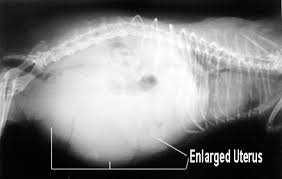 Anyone who is a breeder and has experienced this knows Pyometra in Dogs is Terrifying. New breeders read this article! It is so important you know the risks of breeding and the warning signs that something is very wrong with your female. American Bully breeding has become very popular in the past few years. It is so important to study and do research before becoming a breeding. However many people think breeding is a natural occurrence that the dogs will mate on their own and 63 days later little cash cows will also magically come out on their own. People come out to a show or see a beautiful dog in their neighborhood and decide they are going to be breeders overnight. They jump into the game with little no to knowledge or guidance and can make crucial errors in the process of breeding which can result in sterile or worse… dead females.
Anyone who is a breeder and has experienced this knows Pyometra in Dogs is Terrifying. New breeders read this article! It is so important you know the risks of breeding and the warning signs that something is very wrong with your female. American Bully breeding has become very popular in the past few years. It is so important to study and do research before becoming a breeding. However many people think breeding is a natural occurrence that the dogs will mate on their own and 63 days later little cash cows will also magically come out on their own. People come out to a show or see a beautiful dog in their neighborhood and decide they are going to be breeders overnight. They jump into the game with little no to knowledge or guidance and can make crucial errors in the process of breeding which can result in sterile or worse… dead females.
Pyometra is terrifying! What is it? Pyometra is an infection that occurs as a result of a change within the female’s reproductive tract. Female dogs go into ” heat” this is the same process as a human female having a period. During this stage the females body releases white blood cells to protect them against infection. The cervix is the gateway to the uterus. It remains closed like a bottle cap at all times, except during estrus or heat. At this time, the cervix relaxes causes an opening to allow the sperm to enter. Having a gateway for sperm also means having a gateway for bacteria to get in as well. Bacteria found on the vagina can now easily make their way into the uterus and set up camp. Bacteria in the uterus is the cocktail for serious medical problems.
I just bred my dog and shes not acting right, should I just assume its morning sickness and a normal part of the pregnancy? Absolutely not! Dogs can take a lot more pain then people can. If your dog is showing something is wrong then something is wrong! Do not ignore the signs. Typically symptoms will occur between 2 weeks to 8 weeks after the heat. So novice will confuse with signs their breeding took and assume its normal “pregnancy characteristics”
Most common signs or pyometra include pus or discharge from the vagina. This is not normal. Pus or discharge is a sign of an infection the body is trying to expel. You would most likely notice this around the skin and hair under the tail, or maybe spots or stains on your dogs bed. Accompanied by any infection are fever, sleepiness, anorexia, loss or lack of appetite, vomiting, and depression.
Please don’t take your dogs sleepiness as a sign of pregnancy its not! During pregnancy your dog would remain active until their are very large and nearing the last few days of term.
My dog shows all the signs listed above except a discharge so she must be ok? Wrong, There are 2 types of Pyometra one where the cervix remains open allowing drainage, one the silent killer, where it closes back up and there is no drainage. This form is extremely dangerous because all the pus is collecting inside the uterus as it has no way to drain. This will cause an extended abdomen, which again a novice may assume is a growing belly of a pregnant female. The trapped bacteria will eventually be absorbed into the bloodstream and now have a highway through the entire body. Toxins released from the bacteria will affect the kidneys, making them unable to do their job, this will result in an excessive thirst your dog will not be able to quench. therefore you will see an increased amount of water being drank. Extreme thirst is a sign of both closed and open cervix pyometra.
 Pyometra symptoms are easily detectable to the trained eye, they can easily be confirmed by ultrasound or x-ray at the vet. The vet will look for an enlarged uterus, thickened uterine walls and built up fluid within the uterus.
Pyometra symptoms are easily detectable to the trained eye, they can easily be confirmed by ultrasound or x-ray at the vet. The vet will look for an enlarged uterus, thickened uterine walls and built up fluid within the uterus.
Pyometra treatment can be devastating to a owner. The most common treatment to pyometra is the surgical removal of the uterus and ovaries, a.k.a spay the female. This is not a typical spay it is much more complicated and has higher risk. It will be accompanied by fluids and antibiotics.
There is a second treatment option which will leave the female intact, or able to be bred at a future time. This second treatment is through administering Prostaglandins, which are a group of hormones that lower the blood level of progesterone and re-open the cervix, using contractions to expel the bacteria and pus. This treatment option is not always successful and not always an option based on the seriousness of the pyometra. This option comes with a long list of side effects and could result in long term complications.
Successful treatment of Pyometra can be broken down into catagories based on the type of pyometra.
75-90% sucees ratio in open cervix pyometra in less complicated cases.
Only 25-40% in closed cervix pyometra.
Rate of reoccurance in treated dogs 50-75%!
Future chance of successful breeding 50-75%.
My dog seems to be getting better on their own? I am going to let nature heal her. She’s a tough dog she’ll weather threw it. Incorrect. Survival chances without treatment are VERY, VERY low. Treatment needs to be performed quickly or you can more then likely guarantee a fatal outcome.
Pyometra can happen as a result of breeding and bacteria traveling into the uterus on the sperm train. It can also happen in the absence of breeding, just from your female being in a less then sanitary environment. If your female is in heat and not being bred it is important to keep her environment and her private area clean. If you are breeding, consult an expert. Perform the breeding in a sterile environment with the knowledge of an experienced vet or breeder. Pyometra is also more common in older female dogs who are intact and have never been bred. Each time a female does threw a heat the walls of her uterus may become thicker causing a narrowing of the exit route for bacteria to be expelled. This will lead in the trapping of bacteria and a case of closed cervix pyometra. Spaying a female dog who is finished being bred or you have no intention of breeding will decrease your chance of encountering pyometra.










Good read!
I am a vet tech for the past 25 years and I really enjoyed your article. It is very informative to breeders. Very good article!
I carefully bred a bitch and carefully bred a dog……..waited until they were both mature and cleared (hips and eyes) to be ready for parenthood. I loved both my dogs. They successfully bred, and my wonderful girl ended up with a pyometra. Of course, she was treated immediately, and had an ovariohysterectomy, and I'm lucky (and blessed) that she survived. Then of course, I neutered my male. I'm a registered veterinary technician for nearly 30 years, and thought I was doing everything right. You can't out-think hormones and bacteria, no matter how well you plan. Pyometra is EXPENSIVE, if not deadly.
Thank you everyone for taking the time to read this!